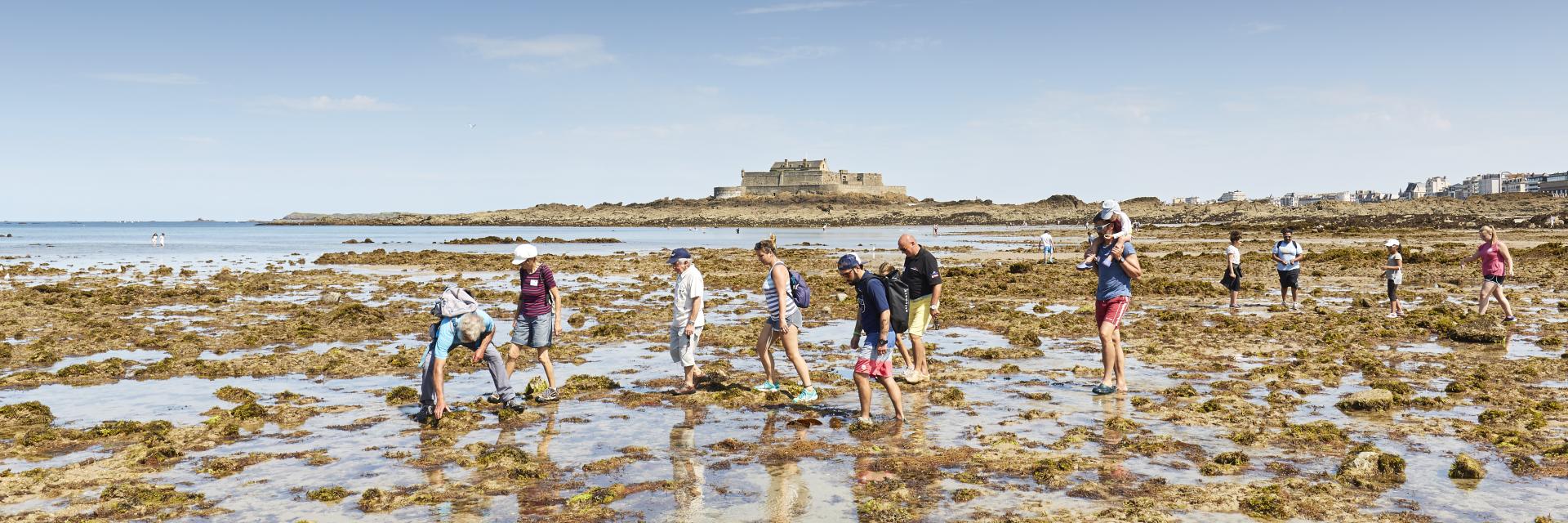 On A Testé Pour Vous Grande Marée Ver De Sable
On A Testé Pour Vous Grande Marée Ver De Sable On A Testé Pour Vous Grande Marée Conférence
On A Testé Pour Vous Grande Marée Conférence ©alamoureux Découverte Guidée Du Littoral (27)
©alamoureux Découverte Guidée Du Littoral (27) On A Testé Pour Vous Grande Marée Ver De Sable
On A Testé Pour Vous Grande Marée Ver De Sable On A Testé Pour Vous Grande Marée Conférence
On A Testé Pour Vous Grande Marée ConférenceIntroductions are made, the start is given and our little group of 36 heads for the large Sillon beach. Our first stop was just in front of the breakwaters, and Yann took a large nautical chart out of his bag. The walk begins with a reading of the landscape, to which he adds some very interesting anecdotes about the history of Saint-Malo and the reason for the breakwaters, which are not only used to break the waves and tides in the Bay of Saint-Malo. A few questions were already being asked, but Yann didn’t answer them all. Several steps further on, we learn a little more about the little people who live in the tidal zone, between the sand worm and its compatriots, accustomed to living 6 hours with their nose in the air and 6 hours with their gills in the water. The green, dark blue and light blue parts of the nautical chart soon hold no more secrets for us.
This is an almost lunar landscape of seaweed-covered rocks that lies before us.
Finally, we arrive at the area of lowest tides, the one that only uncovers during exceptional tides, at the spring and autumn equinoxes. An almost lunar landscape of seaweed-covered rocks lies before us. Cautiously, with our feet in the water, we learn to fish on foot. We start turning over the rocks to observe all the marine flora and fauna. Yann lets us try a seaweed with a subtle peppery flavour and explains that much of the brownish seaweed that populates the foreshore is found in some of our desserts!
 On A Testé Pour Vous Grande Marée Gaspard Le Homard
On A Testé Pour Vous Grande Marée Gaspard Le HomardAll of a sudden, an exclamation makes us turn around: one of our fishing companions has just made the acquaintance of Gaspard the lobster, nestling at the bottom of his pond! He’s beautiful and blue, but a little too small to be brought in and cardinalized (cooked). We’re going to put him back in the water in the waves, so that he can escape his other predators, the gulls, who are watching for the fruit of our efforts a few rocks further on. This is a good opportunity for us to talk about the regulations governing fishing on foot in the area, and we don’t forget to carefully replace any rocks that have been turned over.
 On A Testé Pour Vous Grande Marée Homard
On A Testé Pour Vous Grande Marée Homard ©alamoureux Découverte Guidée Du Littoral (24)
©alamoureux Découverte Guidée Du Littoral (24)We meet up at the foot of the Grand Bé. Yann is already waiting for us there, sampling
some edible plants. Over there is Fort National, where our visit began. Gaspard is already under a few dozen centimetres of water.
We take the path up to the top of the islet and as we pass we say hello to François-René, who is resting facing out to sea. A little higher up, a vast platform of grasses and stones welcomes us and we sit down quietly, in a circle, around Yann.
Now he’s going to introduce us to the mysteries of the cosmos and Europe’s highest tides. Three unfortunate companions are assigned to play the roles of the Sun, Earth and Moon. The explanations are crystal-clear, and it’s time for the surprise quiz! Our guide is a whiz when it comes to natural heritage.
With the tide not waiting, it’s time to head back down from the Grand Bé. We take the footbridge back to Bon Secours beach. We part with stars in our eyes, and a brief thought for Gaspard, already under 4 metres of water!
On a walk along the beaches uncovered by Europe’s highest tides, the naturalist guide will accompany you from the Plage de Fan to the Ile du Grand Bé to discover the landscapes and ecosystems revealed by low tide. After looking at the different species, the expert will explain the phenomenon of the tides.